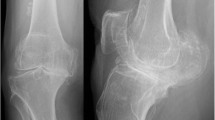Abstract
Displaced fractures of the proximal medial femur in elderly patients with high functional demands are treated with the implantation of a hip replacement. The double articulation cup was used in prosthetic instability, regardless of the causes of instability, with good results. We have treated 539 consecutive patients from 2006 to 2012. The double articulation cup has proven effective in reducing the incidence of dislocations.



Similar content being viewed by others
Bibliografia
Lee BP, Berry DJ, Harmsen WS, Sim FH (1998) Total hip arthroplasty for the treatment of an acute fracture of the femoral neck: long-term results. J Bone Jt Surg Am 80:70–75
Woo RY, Morrey BF (1982) Dislocations after total hip arthroplasty. J Bone Jt Surg Am 64:1295–1306
Paterno SA, Lachiewicz PF, Kelley SS (1997) The influence of patient-related factors and the position of the acetabular component on the rate of dislocation after total hip replacement. J Bone Jt Surg Am 79:1202–1210
Cabamela ME. Hip Society 30th Open Sc. Meet. 200
Bochner RM, Pellicci PM, Lyden JP (1988) Bipolar hemiarthroplasty for fracture of the femoral neck. Clinical review with special emphasis on prosthetic motion. J Bone Jt Surg Am 70:1001–1010
Chan RN, Hoskinson J (1975) Thompson prosthesis for fractured neck of femur. A comparison of surgical approaches. J Bone Jt Surg Br 57:437–443
Kreder HJ, Deyo RA, Koepsell T et al. (1997) Relationship between the volume of total hip replacements performed by providers and the rates of postoperative complications in the state of Washington. J Bone Jt Surg Am 79:485–494
Bartz RL, Nobel PC, Kadakia NR, Tullos HS (2000) The effect of femoral component head size on posterior dislocation of the artificial hip joint. J Bone Jt Surg Am 82:1300–1307
Kelley SS, Lachiewicz PF, Hickman JM, Paterno SM (1998) Relationship of femoral head and acetabular size to the prevalence of dislocation. Clin Orthop Relat Res 355:163–170
Leclerq S, el Blidi S, Aubriot JH (1995) Traitement de la luxation récidivante de prothèse totale de hanche par le cotyle de Bousquet. A propos de 13 cas. Rev Chir Orthop Repar Appar Mot 81:389–394
Delaunay CH (2001) Les luxations precoces des prothèses totales primaires de hanche. Qui de neuf depuis 10 ans? Maîtrise Orthop Oct 2001:107
Fessy MH (2006) La double mobilité. Maîtrise Orthop Mar 2006:152
Barbour PS, Barton DC, Fisher J (1995) The influence of contact stress on the wear of UHMWPE for total replacement hip prostheses. Wear 181–183:250–257
Geringer J, Pellier J, Cleymand F, Forest B (2011) Proceedings of Society of Biomaterials Fretting-corrosion of 316LSS: the role of albumin on the corrosiveb wear application to orthopaedic implants, Orlando
Conflitto di interesse
Nessuno.
Author information
Authors and Affiliations
Corresponding author
Rights and permissions
About this article
Cite this article
Manca, M., Palomba, M., Iacopinelli, M. et al. Percorso di trattamento delle fratture del femore prossimale. L’utilizzo del cotile a doppia articolarità: nuove prospettive e risultati. LO SCALPELLO 27, 54–58 (2013). https://doi.org/10.1007/s11639-013-0024-x
Published:
Issue Date:
DOI: https://doi.org/10.1007/s11639-013-0024-x




